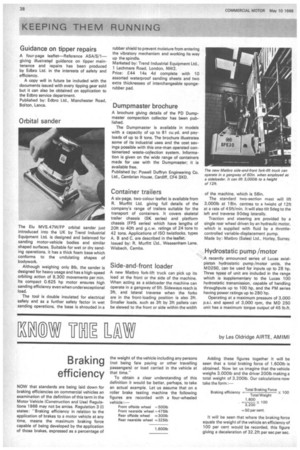Braking efficiency
Page 40

If you've noticed an error in this article please click here to report it so we can fix it.
NOW that standards are being laid down for braking efficiencies on commercial vehicles an examination of the definition of this term in the Motor Vehicle (Construction and Use) Regulations 1966 may not be amiss. Regulation 3 (I) states: "Braking efficiency in relation to the application of brakes to a motor vehicle at any time, means the maximum braking force capable of being developed by the application of those brakes, expressed as a percentage of
the weight of the vehicle including any persons (not being fare paying or other travelling passengers) or load carried in the vehicle at that time.
To obtain a clear understanding of this definition it would be better, perhaps, to take an actual example. Let us assume that on a roller brake testing machine the following figures are recorded with a four-wheeled vehicle : Front offside wheel -.500lb Front nearside wheel =475Ib Rear offside wheel =3001b Rear nearside wheel =325Ib Adding these figures together it will be seen that a total braking force of 1,6001b is obtained. Now let us imagine that the vehicle weighs 3,000lb and the driver 200lb making a total weight of 3,2001b. Our calculations now take the form :— Total Braking Force Braking efficiency X 100 Total Weight 1,600 x 3,200 100 = 50 per cent.
It will be seen that where the braking force equals the weight of the vehicle an efficiency of 100 per cent would be recorded, this figure giving a deceleration of 32.2ft per sec per sec.












































































































